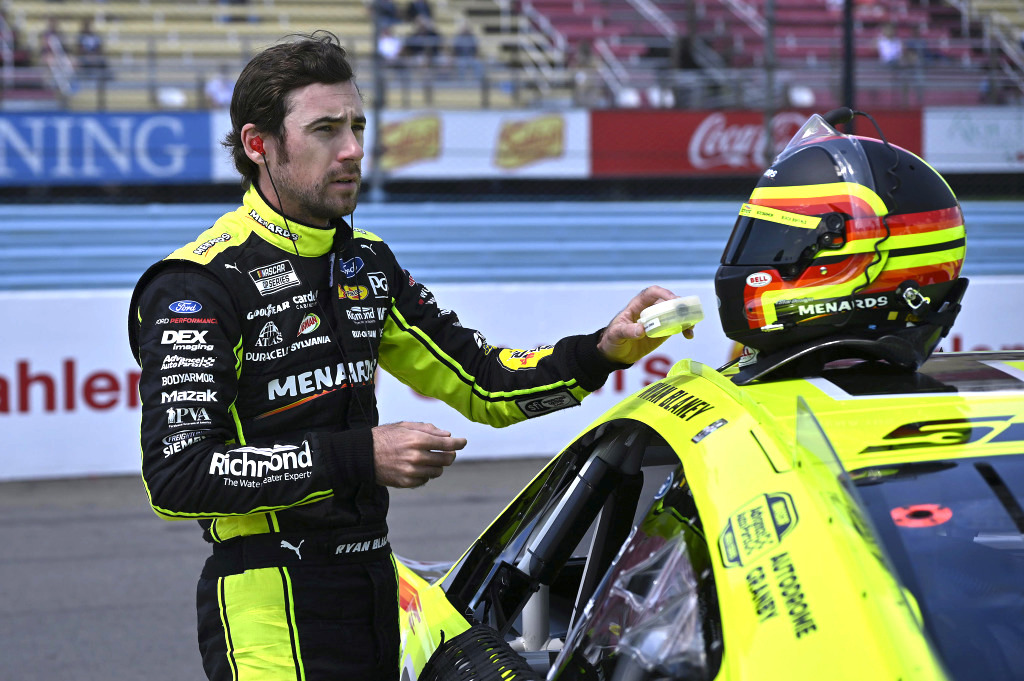Ryan Blaney still has some soreness but is ready to climb back into his Team Penske Ford Mustang after a high-speed frontal impact last weekend in Daytona.
“I’m a little sore still, but (it’s) gotten a lot better over the last two days,” Blaney said at NASCAR Cup Series playoff media day. “I was happy to have Sunday off that’s for sure. That was nice. But I’m starting to feel better and looking forward to this weekend.”
On the final lap of the second stage, Blaney made a move to the inside of Ty Gibbs to take the lead of the inside lane going into Turns 3 and 4. Blaney and Gibbs were side-by-side through the corners when Gibbs was hit from behind by Christopher Bell, which sent Gibbs spinning to the left and hitting the right-side door of Blaney’s car.
Blaney was hooked to the right and sent head-on into the outside wall. Fortunately, it was a SAFER barrier-protected wall, and although Blaney took his time appearing to catch his breath before climbing out of his No. 12 Ford, he was checked and released from the infield care center.
There was no bruising from any of the safety belts. The right side of Blaney’s chest was sore for a few days, and there have been other soreness in his neck and back.
“Nothing too severe,” Blaney said.
[lawrence-auto-related count=3 category=1428]
Blaney did look through all the data from his crash impact. He does not believe he hit the steering wheel, but he did say it was “by far” the most G-forces he’s experienced in his NASCAR career. What those G-forces were is unknown, Blaney admitting he’s not sure if he’s allowed to say.
NASCAR does not make that information public. Blaney did reveal it was more than what he experienced at Nashville in June when he hit an unprotected wall.
“I felt better after this (crash),” Blaney said when comparing the Daytona impact to the Nashville incident. “I think some of the circumstances involved in it helped. My body felt more sore after this one than my head, so that was good.”

Blaney did not miss a race after the Nashville crash, which was also a frontal impact after he was spun on a restart. While coming up to speed, Blaney was hit from behind and spun through the infield grass, with the car hitting an inside wall at the exit of pit road.
“I think the front clip updates definitely helped me,” Blaney said. “Obviously, hitting a SAFER barrier wall was a positive. But I think the front clip updates were huge. I feel like if those weren’t in and we wrecked at Daytona, it would have been a lot worse for sure. It’s good to see that it helped out a little bit. (It) crushed more — as best it could.”
Wednesday, Blaney also reviewed the crash with NASCAR and the individuals from Wake Forest University who consult on the mouthpieces used to gather data from crashes. Blaney has worn one most of the season, and he was doing so last weekend during the Daytona crash.
“I’ve worn it most of the year (and) worked with Wake Forest on getting that thing fitting good to where it’s comfortable for me to wear it all race,” Blaney said. “And it is helpful wearing that thing. I didn’t have it in at Nashville, but I did at Daytona and talking to (NASCAR’s John) Patalak and all those guys at Wake Forest, the data they get off that stuff is huge of what we go through in a hit like that.
“They have the car data, but then what we’re feeling, it’s big for them too. It’s important for that mouthpiece for their research.”
Blaney was complimentary of his conversation with NASCAR on the crash data. Included was Blaney’s in-car data and camera, and there was discussion on what went well and what those involved would like to see changed.
“I was very happy with how I was inside the car; I don’t really know what to do different,” Blaney said. “There’s a couple of things we talked about but they’re always open with that. They want to hear our feedback, and I want to hear what they think … ‘OK, are you guys happy with this? What did you like? What did you not like? When you saw all this stuff when you got the car back, what do you think for the future?’
“I’m always curious about that stuff, and I’m always very open to give my feedback. Our feedback to NASCAR, what it feels like, and where we think we can improve — it’s important for them to try to go forward. So, when you have something like that, it’s part of your job to be as helpful as you can talking to NASCAR about where to go.”
NASCAR begins its playoffs this weekend at Darlington Raceway, and Blaney’s pursuit of a championship starts from the 12 seed. Sunday night is a 500-mile race at a racetrack with a reputation for being hard on cars and drivers.
But for Blaney, he’s not worried at all about how he’s going to feel.
(It’ll) be all good,” he said.
